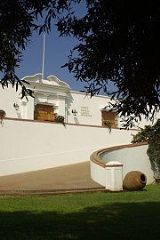
Larco Museum
Encyclopedia
The Larco Museum is a privately owned museum of pre-Columbian
art, located in the Pueblo Libre
District of Lima
, Peru
. The museum is housed in an 18th century vice-royal
mansion built over a 7th century pre-Columbian pyramid
. It showcases chronological galleries that provide a thorough overview of 4,000 of Peruvian pre-Columbian history. It boasts one of the world's largest collections of pre-Columbian art
including Moche
, Nazca
, Chimú, and Inca pieces. Additionally, the Larco Museum is well known for its gallery of pre-Columbian erotic pottery.
It was one of the first museums in the world to make its entire 45,000 piece collection available in an online electronic catalog.
. Soon after, Larco Herrera left his son in charge of the collection and those pieces completed the first collection of what would become the Rafael Larco Herrera Museum.
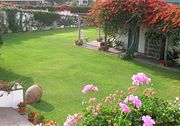 During that same year, Larco Hoyle received some advice from his uncle, Victor Larco Herrera, a founder of the first museum in Lima. He urged Larco Hoyle to form a new museum in Lima, one that could guard all the archaeological relics that were continually being extracted by clandestine excavators.
During that same year, Larco Hoyle received some advice from his uncle, Victor Larco Herrera, a founder of the first museum in Lima. He urged Larco Hoyle to form a new museum in Lima, one that could guard all the archaeological relics that were continually being extracted by clandestine excavators.
Larco Hoyle agreed with his uncle and proceeded to create a museum that would carry on his father's legacy. Larco Hoyle purchased two large collections: 8,000 pieces from Roa and 6,000 pieces from Carranza. He also purchased several small collections in Chicama Valley, Trujillo
, Virú
, and Chimbote
. Within a year, the collection had grown significantly and display cases were installed in a small house on the Chiclín estate. On July 28, 1926, Independence Day, the museum opened its doors to the public.
The Larco Museum now lends some of its collection to its daughter museum, the Museo de Arte Precolombino (Pre-Columbian Art Museum), located in Cusco
, Peru.
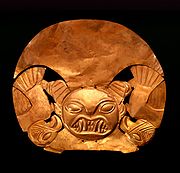
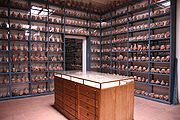 The Museum has several permanent exhibitions. The Gold and Silver Gallery showcases the largest collection of jewelry used by many notable rulers of pre-Columbian Peru. It comprises an impressive collection of crowns, earrings, nose ornaments, garments, masks and vases, finely wrought in gold and decorated with semi-precious stones. The Erotic Gallery has become one of South America's most popular attractions. Ancient Peruvian cultures represented their daily lives in ceramics, and this gallery holds the world's largest collection of erotic ceramics.
The Museum has several permanent exhibitions. The Gold and Silver Gallery showcases the largest collection of jewelry used by many notable rulers of pre-Columbian Peru. It comprises an impressive collection of crowns, earrings, nose ornaments, garments, masks and vases, finely wrought in gold and decorated with semi-precious stones. The Erotic Gallery has become one of South America's most popular attractions. Ancient Peruvian cultures represented their daily lives in ceramics, and this gallery holds the world's largest collection of erotic ceramics.
The Cultures Gallery exhibits 40,000 years of Peruvian pre-Columbian history. This chronology-based gallery provides visitors with a comprehensive view of cultures that existed in pre-Columbian Peru through the extant indigenous art that has survived since the 16th century Spanish conquest. This hall is divided into four areas: North Coast, Center, South and cultures from the highlands. Showcases have been ordered according to cultural sequence:
Other galleries include the Lithic, Vault, Ceramics, Metals, Textiles and Storage in which visitors have the opportunity to view the Museum's entire collection of classified archaeological objects.
, Japan
and Budapest
, Hungary
.

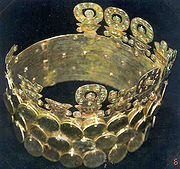 The Larco Museum prides itself in the conservation and restoration of Peru's archaeological patrimony. With over 80 years of experience, the Museum has become one of the most prestigious institutions on conservation and restoration of archaeological Peruvian objects. The Museum houses conservation laboratories for textiles, ceramics and metals.
The Larco Museum prides itself in the conservation and restoration of Peru's archaeological patrimony. With over 80 years of experience, the Museum has become one of the most prestigious institutions on conservation and restoration of archaeological Peruvian objects. The Museum houses conservation laboratories for textiles, ceramics and metals.
The Museum Gallery Shop has a wide variety of ceramic, metal and textile reproductions made by skilled craftsmen from all over Peru. The museum has formalized the reproduction techniques for these pre-Columbian artifacts and assesses each piece to ensure quality.
HStern Jewellers and Kuna by Alpaca 111 also have storefronts at the Museum. The Museum also features gardens that have received a Colonial Garden award from Peru.
Pre-Columbian
The pre-Columbian era incorporates all period subdivisions in the history and prehistory of the Americas before the appearance of significant European influences on the American continents, spanning the time of the original settlement in the Upper Paleolithic period to European colonization during...
art, located in the Pueblo Libre
Pueblo Libre
Pueblo Libre is a district of the Lima Province in Peru and one of the districts that comprise the city of Lima. Its name, which means Free Town or Free People, was granted by José de San Martín on April 10, 1822 as a recognition of the patriotism shown by its inhabitants during the Peruvian War of...
District of Lima
Lima
Lima is the capital and the largest city of Peru. It is located in the valleys of the Chillón, Rímac and Lurín rivers, in the central part of the country, on a desert coast overlooking the Pacific Ocean. Together with the seaport of Callao, it forms a contiguous urban area known as the Lima...
, Peru
Peru
Peru , officially the Republic of Peru , is a country in western South America. It is bordered on the north by Ecuador and Colombia, on the east by Brazil, on the southeast by Bolivia, on the south by Chile, and on the west by the Pacific Ocean....
. The museum is housed in an 18th century vice-royal
Viceroyalty of Peru
Created in 1542, the Viceroyalty of Peru was a Spanish colonial administrative district that originally contained most of Spanish-ruled South America, governed from the capital of Lima...
mansion built over a 7th century pre-Columbian pyramid
Pyramid
A pyramid is a structure whose outer surfaces are triangular and converge at a single point. The base of a pyramid can be trilateral, quadrilateral, or any polygon shape, meaning that a pyramid has at least three triangular surfaces...
. It showcases chronological galleries that provide a thorough overview of 4,000 of Peruvian pre-Columbian history. It boasts one of the world's largest collections of pre-Columbian art
Pre-Columbian art
Pre-Columbian art is the visual arts of indigenous peoples of the Caribbean, North, Central, and South Americas until the late 15th and early 16th centuries, and the time period marked by Christopher Columbus' arrival in the Americas....
including Moche
Moche
'The Moche civilization flourished in northern Peru from about 100 AD to 800 AD, during the Regional Development Epoch. While this issue is the subject of some debate, many scholars contend that the Moche were not politically organized as a monolithic empire or state...
, Nazca
Nazca culture
The Nazca culture was the archaeological culture that flourished from 100 to 800 CE beside the dry southern coast of Peru in the river valleys of the Rio Grande de Nazca drainage and the Ica Valley...
, Chimú, and Inca pieces. Additionally, the Larco Museum is well known for its gallery of pre-Columbian erotic pottery.
It was one of the first museums in the world to make its entire 45,000 piece collection available in an online electronic catalog.
History
In 1925, Rafael Larco Herrera acquired a collection of vases and other archaeological pieces from Alfredo Hoyle, who was his brother-in-law. There were approximately 600 ceramic pieces in all. The arrival of these objects ignited a collector's enthusiasm in his son, Rafael Larco HoyleRafael Larco Hoyle
Rafael Larco Hoyle , raised at Chiclin, his family's estate, was sent to school in Maryland, USA, at the age of twelve. He later entered Cornell University to study agricultural engineering and by 1923 returned to Peru to work on the family's sugar cane plantation...
. Soon after, Larco Herrera left his son in charge of the collection and those pieces completed the first collection of what would become the Rafael Larco Herrera Museum.

Larco Hoyle agreed with his uncle and proceeded to create a museum that would carry on his father's legacy. Larco Hoyle purchased two large collections: 8,000 pieces from Roa and 6,000 pieces from Carranza. He also purchased several small collections in Chicama Valley, Trujillo
Trujillo, Peru
Trujillo, in northwestern Peru, is the capital of the La Libertad Region, and the third largest city in Peru. The urban area has 811,979 inhabitants and is an economic hub in northern Peru...
, Virú
Virú Province
The Virú Province is one of twelve provinces of the La Libertad Region in Peru. The capital of this province is the city of Virú.-Political division:The province is divided into three districts, which are:* Chao* Guadalupito* Virú-External links:...
, and Chimbote
Chimbote
Chimbote is the largest city in the Ancash Region of Peru, and the capital of both Santa Province and Chimbote District.The city is located on the coast in Chimbote Bay, south of Trujillo and north of Lima on the North Pan-American highway. It is the start of a chain of important cities like...
. Within a year, the collection had grown significantly and display cases were installed in a small house on the Chiclín estate. On July 28, 1926, Independence Day, the museum opened its doors to the public.
The Larco Museum now lends some of its collection to its daughter museum, the Museo de Arte Precolombino (Pre-Columbian Art Museum), located in Cusco
Cusco
Cusco , often spelled Cuzco , is a city in southeastern Peru, near the Urubamba Valley of the Andes mountain range. It is the capital of the Cusco Region as well as the Cuzco Province. In 2007, the city had a population of 358,935 which was triple the figure of 20 years ago...
, Peru.
Permanent exhibits


The Cultures Gallery exhibits 40,000 years of Peruvian pre-Columbian history. This chronology-based gallery provides visitors with a comprehensive view of cultures that existed in pre-Columbian Peru through the extant indigenous art that has survived since the 16th century Spanish conquest. This hall is divided into four areas: North Coast, Center, South and cultures from the highlands. Showcases have been ordered according to cultural sequence:
- From the North Coast: CupisniqueCupisniqueCupisnique was a pre-Columbian culture which flourished from ca. 1000 to 200 BC along what is presently Peru's Pacific Coast. The culture had a distinctive style of adobe clay architecture but shared artistic styles and religious symbols with the later Chavin culture which arose in the same area at...
, VicusVicus (Peru)Vicús culture was an important early culture in Peru from 1000/200 BCE to 300/600 CE. They lived in the Piura region in the northwestern coast of Peru.-Art:They were known for their work in ceramics , copper, and gold...
, Mochica and Chimu; - From the Central Coast: LimaLima cultureThe Lima culture was an indigenous civilization which existed in modern day Peru from A.D. 100 to A.D. 650. This pre-Incan culture was located in the Chillon, Rimac and Lurin River valleys. This civilization was known for its ceramic artwork. The Lima Civilizaton constructed many temples known as...
and Chancay; - From the South Coast: ParacasParacasParacas may refer to:* Paracas culture, an important Andean society that existed in Peru between approximately 750 BC and 100 AD* Paracas Peninsula, located in the Ica Region of Peru* Paracas Bay, located in the Pisco Province of the Ica Region in Peru...
, NazcaNazca cultureThe Nazca culture was the archaeological culture that flourished from 100 to 800 CE beside the dry southern coast of Peru in the river valleys of the Rio Grande de Nazca drainage and the Ica Valley...
and Chincha; - From the Highlands: ChavínChavín cultureThe Chavín were a civilization that developed in the northern Andean highlands of Peru from 900 BC to 200 BC. They extended their influence to other civilizations along the coast. The Chavín were located in the Mosna Valley where the Mosna and Huachecsa rivers merge...
, Tiahuanaco, HuariHuari CultureThe Wari were a Middle Horizon civilization that flourished in the south-central Andes and coastal area of modern-day Peru, from about CE 500 to 1000...
and IncaInca societyThe society of the Inca Empire was centered in what is now Peru, from 1438 BC to 1533 AD. Over that period, the Inca used conquest and peaceful assimilation to incorporate in their empire a large portion of western South America, centered on the Andean mountain ranges...
.
Other galleries include the Lithic, Vault, Ceramics, Metals, Textiles and Storage in which visitors have the opportunity to view the Museum's entire collection of classified archaeological objects.
International exhibits
In addition to its permanent exhibits, the Larco Museum lends its collections to several museums and cultural centers around the world. Currently, there are traveling exhibits in TokyoTokyo
, ; officially , is one of the 47 prefectures of Japan. Tokyo is the capital of Japan, the center of the Greater Tokyo Area, and the largest metropolitan area of Japan. It is the seat of the Japanese government and the Imperial Palace, and the home of the Japanese Imperial Family...
, Japan
Japan
Japan is an island nation in East Asia. Located in the Pacific Ocean, it lies to the east of the Sea of Japan, China, North Korea, South Korea and Russia, stretching from the Sea of Okhotsk in the north to the East China Sea and Taiwan in the south...
and Budapest
Budapest
Budapest is the capital of Hungary. As the largest city of Hungary, it is the country's principal political, cultural, commercial, industrial, and transportation centre. In 2011, Budapest had 1,733,685 inhabitants, down from its 1989 peak of 2,113,645 due to suburbanization. The Budapest Commuter...
, Hungary
Hungary
Hungary , officially the Republic of Hungary , is a landlocked country in Central Europe. It is situated in the Carpathian Basin and is bordered by Slovakia to the north, Ukraine and Romania to the east, Serbia and Croatia to the south, Slovenia to the southwest and Austria to the west. The...
.
Conservation


Other points of interest
The Museum Café is a restaurant located in the terrace and garden of the museum. Its interior, designed by architect Jordi Puig, provides the ambiance of an old chateau.The Museum Gallery Shop has a wide variety of ceramic, metal and textile reproductions made by skilled craftsmen from all over Peru. The museum has formalized the reproduction techniques for these pre-Columbian artifacts and assesses each piece to ensure quality.
HStern Jewellers and Kuna by Alpaca 111 also have storefronts at the Museum. The Museum also features gardens that have received a Colonial Garden award from Peru.

